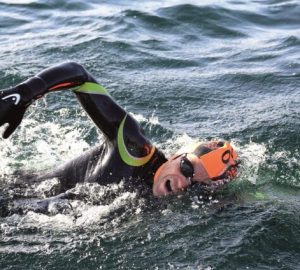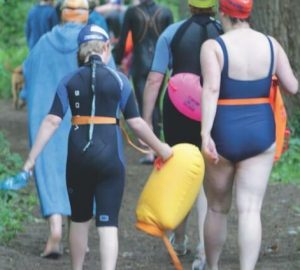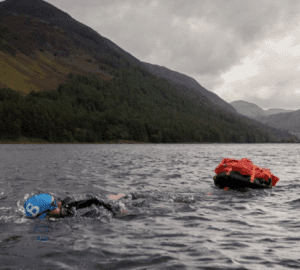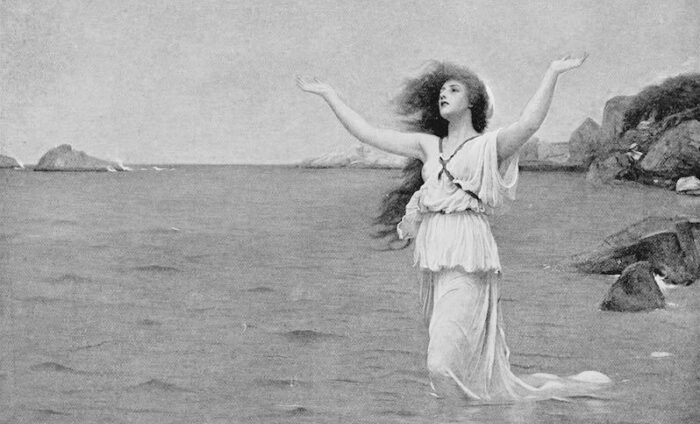
Advice for women
“Dear reader, when you swim, do not go about like a floating coffin, but be cheerful, enjoy yourself.” Jenny Landreth, author of Swell, A Waterbiography, explores the advice given to female swimmers in the 19th century
Writing a book that has an element of social history, I spent quite a lot of time scratching round in the dust of old documents. Some of these documents were dry in every sense, or written in such obfuscating language my eyes would almost rebel against reading them. But every now and again I’d turn up a little bit of treasure. This treasure might not look how you’d expect; for me, it was not always found in the showiest, most glittering writing, or the earthshattering philosophical truth. Sometimes, what I found to be treasure were a few words that gave me a fantastic image, or a glimpse beyond what I was expecting. It was always a bonus if it made me laugh.
Like this one sentence I found in an educational publication produced in 1865. The snappily-titled Ladies National Association for the Diffusion of Sanitary Knowledge were essentially a bunch of educated upper-class women trying to improve the lot of poorer, working-class women via a series of invigorating pamphlets. It might sound, well, dreadful – patronising and privileged – and in lots of senses they weren’t very progressive; they perpetuated the idea that women should stay in their lane as home-makers and child-bearers. But their intentions were pretty solid, and alongside stuff around the health of mothers and the benefits of fresh air, they produced 14 pages on Why Do Women Not Swim.
Now, there’s actually a whole raft of reasons why women didn’t swim at that point, not least because there were very few places they could swim. The first public pool in London to reluctantly admit women was Marylebone Baths in 1858, and the entrance fee was pitched at a level ‘quite sufficient to keep it select’. It wasn’t like working class women were just being slack. Also, it would have only been recently that the last woman was unofficially ‘swum as a witch’ in rural Britain, if you’re looking for a really clear contrast between the lives of educated middle class women – all swimming pamphlets and Associations – and uneducated, ordinary ones, still being dunked and drowned if their personality didn’t fit. In British history, class is our Great Wall of China; everything is one side or the other and it’s so dominant you can practically see it from space.
Nonetheless, this swimming pamphlet encouraged women to stop being passive, which in itself was quite a radical proposal, and included a sentence I relish: ‘So you, dear reader, when you swim, do not go about like a floating coffin, but be cheerful, enjoy yourself’. It made me chuckle, the sheer absurdity of that image – Victorian women lying silent and immobile in water, mournfully bumping into each other like gloomy wooden boxes, determinedly miserable. It feels a bit Monty Python. Whatever, it’s a little bit of visual treasure that gives us stuff to unpick.
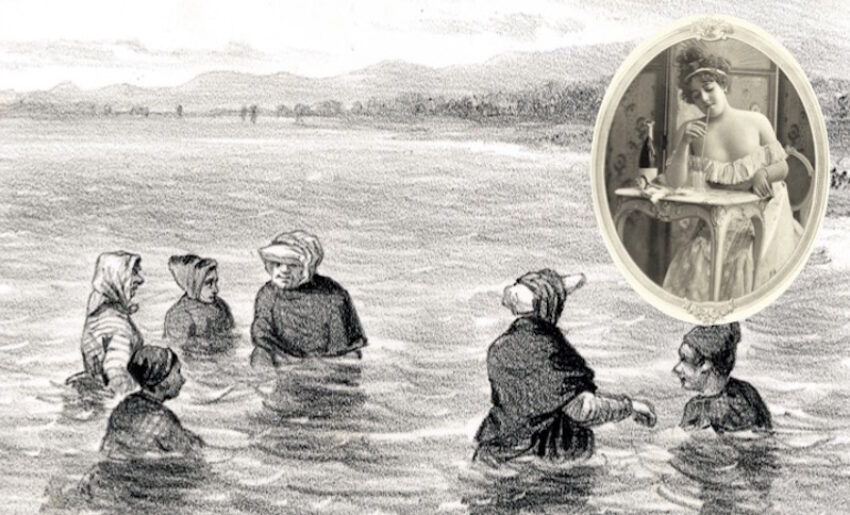
First of all, this might not have felt much like freedom. The floating coffin women would have been wearing more clothes in the water than we’d wear to go to the Arctic. So actually, just lying on the surface bumping around like boxes might have been all they could accomplish; dressed in all their garb, it’s actually pretty good going not to sink miserably to the bottom. Secondly, women just didn’t have had the opportunity to learn to swim. Their brothers, fathers, uncles – yes. Them? No, it was unusual, the tide was only just turning in that direction. Could the men have taught them? Well, only from a distance. If they’d gone to the beach, there were mixed bathing by-laws that led to situations like this one in Hastings, where a man was required to stand 30 yards from his wife, vainly shouting directions to her while she tried to learn the basics of swimming. You can picture him, standing some way up the beach, bellowing fruitlessly to the woman in the water, ‘Move your arms, dear. YOUR ARMS’.
One of the key public figures in the promotion of women’s swimming was one Mrs Frances Hoggan, and in 1879 she wrote a paper on ‘Swimming and Its Relation to the Health of Women’. It was full of information about the general benefits of swimming, and questioned why that benefit should be restricted to men, particularly when it was women who, according to Hoggan, would physically and mentally benefit most from it. Why did she feel that women in particular needed to swim? Her reasons make you wonder if she’s describing actual people, or goldfish taken out of their bowl and left to flap around on the side. Swimming, she said, encourages ‘lungs which in ordinary life breathe but feebly’. It allows movement of the hip joint ‘which otherwise is seldom moved with any degree of freedom’. It eases backaches caused by ‘the languid movements which are often encouraged in girls as being more graceful’. And, referring to the corsets women were forced to wear, it helps with ‘the injurious practice of encasing in steel’. These poor middle-class women – panting for breath, stiff, practically motionless, in permanent pain – god, they needed to swim.
Swimming was sold on two premises, neither of which I’m a great fan of. Firstly, it was all about improving your grace and elegance. Other sports might make you look sweaty and ugly and distinctly less feminine, but not swimming. Secondly, and ultimately, if swimming helped women to be healthier, we would be better able to carry out our higher calling, that of being excellent wives and mothers. It’s almost enough, frankly, to make you stop swimming altogether.

It wasn’t just the Ladies National Association telling women how to behave in the pool. Swimming and bathing were becoming fashionable towards the end of the 1800s, so writers took the opportunity to advise ‘the fair sex’ on how to approach it.
My scratching around dug up a couple of charming pieces which share two themes – hair and booze. The first theme gives you some idea of the shallowness of the waters of women’s supposed concerns, the second I’ll admit I found slightly more surprising. Two hours after breakfast, one newspaper writer said in 1893, ladies should ‘undress as quickly as possible and enter the water boldly’. I think that remains good advice – you can always tell the people taking their first dip of the year in English coastal waters. They’re in the water up to their blue-mottled thighs, waiting for that very particular ‘right’ wave, rising on tiptoes or giving a little jump to avoid cold splashes on bare bellies. Just get in! Another writer advised that ‘delicate women and children who suffer from cold feet even in summer, would do well to take off their sandals for a few minutes before entering the sea so as to warm their feet and ankles on the sun-baked sand; and such persons will find it is advisable to take a few drops of Malaga or port before entering the sea.’ It’s hard to argue against taking off your sandals, but having a drink before you swim? That’s fallen right out of favour, even for those cold-ankled ‘delicate women’ among us. Call it health and safety gone mad.
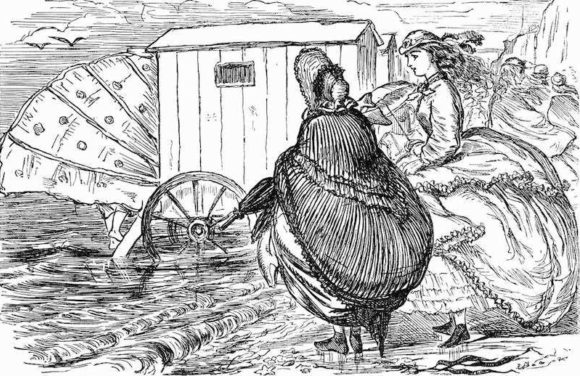
Both writers knew that hair would be an issue. The first piece urged ladies to ‘[take] care to wet the top of the head even if, in deference to luxurious tresses, a regular “duck” is not effected’. I love the phrase ‘luxurious tresses’. It makes me think of shampoo ads, and being worth it. The second writer was also attuned to the potential horrors, stating that women should take care ‘to cover up the hair carefully, as there is nothing so disastrous in effect to a woman’s hair as sea-water.’ It’s true, there is nothing worse, even the very thought makes me lie down on a chaise longue and partake of a few more drops of port. And when I think of all the amazing swimming women I know, completing extraordinary sporting feats, I feel quite faint with distress on their behalf, the thought of all that exercise ruining their tresses. More port, please.
The newspaper advice continued. ‘Take a succession of brisk dips immersing the body right up to the chin, and then retire to the machine [the bathing hut] having spent under five minutes in the water’ it said. All that fuss for five minutes! And after your humungous effort, the paper decreed that if your teeth are chattering and you have ‘a blue appearance around the mouth and nails, a little good brandy must be taken’. Basically, if you didn’t have a drink before you got in, make up for it afterwards. It’s expected of you! And the image it all creates, that there were hordes of hypothermic women with damp hair and blue lips staggering around the beaches of Britain necking brandy, in an era that definitely pre-dates the hen night, well, that’s my idea of a little bit of treasure.
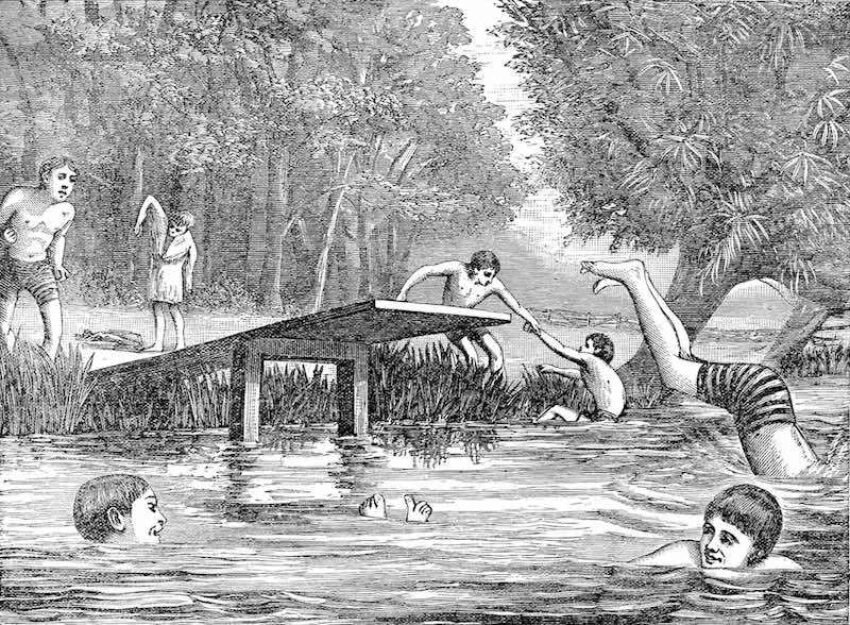
Jenny Landreth is the author of Swell, A Waterbiography, published by Bloomsbury in May 2017.






